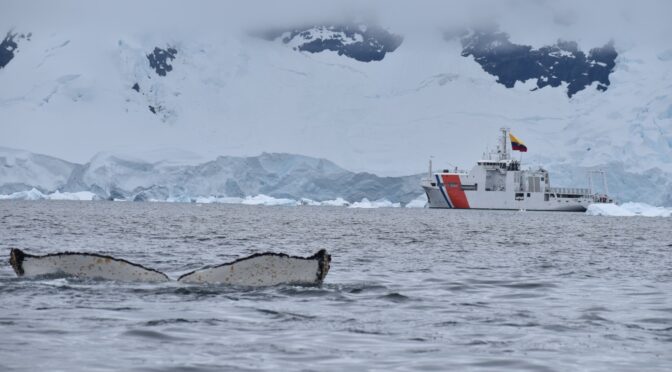By Aaron Delano-Johnson and Myles McCarthy
Introduction
Sporting the distinctive racing stripe worn by many of the globe’s coast guards, the world’s newest polar-capable research vessel left the protected waters of the Gerlache Strait behind as it prepared to cross the Southern Ocean after completing its maiden voyage to Antarctica earlier this year. This cutting-edge vessel was not from a NATO country, Russia, or China, but Colombia, as it set sail from its homeport of Cartagena joining the ranks of South American countries operating ice-capable vessels and research stations on the seventh continent. As the United States and its allies struggle to project surface presence in the high latitudes, the ARC Simon Bolivar (PO-151) joins Chilean icebreaker CNS Almirante Viel (AGB-46) as the second domestically built polar-capable vessel to be commissioned in South America in the last 12 months. If the United States is serious about building capacity to operate at-sea in the high latitudes, it is time to look south.
The challenge of building high latitude maritime capacity
The National Strategy for the Arctic Region calls to expand the “U.S. Coast Guard icebreaker fleet to support persistent presence in the U.S. Arctic and additional presence as needed in the European Arctic.” Likewise, United States Policy on the Antarctic Region also identifies the need to expand the United States polar icebreaker fleet to maintain an active and influential presence in the region to support United States interests across the Antarctic Treaty System.
The struggles to meet either goal are well-documented with critiques of the U.S. Coast Guard’s current icebreaker fleet, Polar Security Cutter program, and the broader state of United States shipbuilding continually in the news. What is not addressed in this debate about icebreaker capacity at-sea is that once the United States polar icebreaker fleet is recapitalized through new construction, or commercially procured stop-gap options, who will operate and maintain these ships in the harshest of environments?
Partnerships with traditional Arctic allies are a natural fit to build knowledge, skills and abilities of high latitude operations, but with a dearth of opportunities onboard both United States and NATO vessels operating in the polar regions, where else should the U.S. Coast Guard and Navy turn to learn from those with these skills and platforms? Look south.
South America’s Efforts in Antarctica
Stories of the Arctic and Antarctic studied in the United States tend to focus on the achievements of polar explorers from Shackleton to Amundsen, Soviet nuclear icebreakers, the indigenous peoples of the Arctic or perhaps the U.S. Antarctic Program’s work at McMurdo Station. Few are aware of the high-latitude capacity possessed by nations across South America, the same countries who are the closest partners of the United States in countering transnational organized crime, operating in the joint naval domain, and addressing illegal, unregulated, and unreported fishing at sea.
Amongst them are upwards of 30 research stations, to include year-round presence at 12, a variety of aircraft launching from Chile and Argentina to support operations on Antarctica, and numerous icebreakers or polar research vessels by their navies or respective maritime services.
In a flurry of activity over recent years, the domestic construction or commercial procurement across South America’s polar fleet includes: Argentina will double its heavy icebreaker fleet with the construction of a second Polar Class 4 vessel set for the late 2020s to sail alongside ARA Almirante Irízar (Q-5), the Peruvian Navy commissioned the BAP Carrasco (BOP-171) Polar Class 7 oceanographic and research vessel (2017), the Colombian General Maritime Directorate’s (DIMAR) ARC Simon Bolivar (PO-151) Lloyd’s Register Ice Class 1C FS (2023), the Chilean CNS Almirante Viel (AGB-46) Polar Class 5 was commissioned in July, while the Brazilian Navy awaits delivery of its next-generation, and domestically built icebreaker, dubbed the Antarctic Support Ship expected to be launched in 2025. Finally, Uruguay procured the R/V Mount Whitney, an ice-strengthened research vessel re-flagged in September as the Oyarvide (ROU-22), to reinvigorate support for scientific investigation and logistics for its Antarctic operations.
Polar expertise can also be found ashore. The School of Marine Sciences of the Argentine Navy hosts the International Maritime Organization (IMO) certified courses of Basic and Advance Navigation in Polar Waters while their Chilean Navy counterparts at the Maritime Training and Instruction Center offer a similar Basic and Advanced Polar Water Operations Course. Both courses are requirements for senior officers serving on their nations’ respective Polar Icebreakers, and each routinely welcomes international students, principally from Europe.
While the United States’ ongoing attempt to recapitalize the ice breaking fleet languishes with delays, it is clear that United States Allies, partners, and adversaries continue, with greater frequency, to put ships into the ice.
Icy Operations: How U.S. Forces Are Engaging the Polar South
Collaborating with South American partners allows the United States to take advantage of a simple fact of geography: when summer precludes cold weather training in the Northern Hemisphere, opportunities abound south of the equator.
Who has looked south to expand opportunities for gaining proficiency in extreme conditions? The U.S. Army’s storied 10th Mountain Division, the 1st Marine Division, U.S. Special Operations Command South, and U.S. Army Mountain Warfare School have all attend the Chilean Mountain Warfare School while U.S. Marine Corps Mountain Warfare Training Center instructors have trained alongside the Argentinian Marines in Ushuaia practicing cold weather tactics and exchanging experiences. Likewise, troops from the Argentinian Mountain Warfare School and Chilean Marines have trained with their U.S. Army counterparts at the Northern Warfare Training Center and the Marine Corps Mountain Warfare Training Center. In addition to ongoing activities in Chile, recent key leader engagements with Argentina have advanced discussions on additional cold weather operations subject matter exchanges.
The U.S. Coast Guard of course does have partnerships and conducts international engagements across the region from exercises to Security Cooperation. But for as much success as USCGC James’ had during its recent port visits along the east coast of South America as the ship conducted illegal, unreported, unregulated fishing operations in the South Atlantic, efforts by the U.S. to bolster polar cooperation in the region have been much more limited.
Most recently, while returning from their annual mission to re-supply McMurdo Station during the 2023 Antarctic season, USCGC Polar Star deviated from their normal trans-Pacific route to visit Punta Arenas and Valparaiso, Chile. These were the first visits to Chile by a U.S. Coast Guard cutter in over seven years and the first to Punta Arenas since 1987, and though the ship enjoyed a warm reception by their Chilean hosts including bilateral engagements, no repeat visit to the continent was made during the ship’s 2024 deployment.
How to Build High Latitude Bench Strength at Sea
What would polar partnerships in South America offer to the U.S. Coast Guard and Navy? To begin, the need for added bench strength of operators with high latitude experience is real. Currently the U.S. Coast Guard’s high latitude efforts focus on preparing the heavy icebreaker USCGC Polar Star and medium icebreaker USCGC Healy for annual missions to Antarctica and the U.S. Arctic respectively. Healy and Polar Star represent the only two platforms in the United States’ combined fleet capable of training ice pilots, the essential qualification for operating ships in ice. On average, each qualifies just four to five new ice pilots a year, and given the rate of attrition in the U.S. Coast Guard’s Cutterman community, this leaves a very small candidate pool from which to fill current command cadre needs. And projected forward, this trajectory will leave the service critically short of the crews necessary for the nation’s envisioned future icebreaking fleet of Polar Security Cutters.
Since 2018 the U.S Coast Guard has looked to the Afloat Ice Breaking Training Program to help fill these gaps. However, the program is imperfect, and proposals to expand it are stymied by a critical factor: in an average year the United States only has one ship breaking international ice at a time, limiting space for trainees. So why not look to the rapidly expanding South American polar fleet for assistance? Precedent already exists for personnel exchanges in the region. Currently, the U.S. Navy has Surface Warfare Officers participating in two year exchange programs in Brazil, Colombia, Peru, Argentina, and Chile, with some calling to expand the program even wider.
And personnel exchanges should work in both directions, as the U.S. Coast Guard can offer invitations to join icebreaking deployments to officers from South American countries in the same way these opportunities are currently extended to their NATO, Australian, and New Zealand counterparts. Similarly, the U.S. Navy’s Second Fleet recently concluded Operation Nanook, a Canadian led multinational exercise that while focused on the Arctic and NATO partnerships would certainly offer many lessons learned to South American nations with Antarctic interests. Put another way, polar officers need to know more than just the mechanics of how to operate a ship in ice, they need to understand the interests, ideology, and capabilities of all partner nations in the rapidly evolving high-latitudes.
Potential opportunities to build bench strength are not just limited to expanding the Icebreaking Training Program. Junior officers aboard Healy and Polar Star could take advantage of their ships’ lengthy annual maintenance periods to seek temporary duty opportunities either aboard a ship or even by attending the aforementioned polar navigation courses in Argentina or Chile.
Finally, it takes herculean efforts in logistics to keep the aging U.S. icebreakers on mission. Forging mission support partnerships is often an afterthought that operational commanders scramble to expedite in times of crises. Establishing strategic logistics relationships with partner maritime services that can facilitate spare parts deliveries, conduct at highly capable shipyards across South America, and streamlined agreements for diplomatic clearances should all be a priority for engagement in the region.
Conclusion
Afloat operations in the polar regions are fraught with risk. The United States needs to come to the region with not just capable ships, but with strong international partnerships and well-trained crews. With an icebreaking fleet that has historically relied upon on-the-job training to qualify the next generation of polar explorers, the U.S. Coast Guard’s “red hull” community currently struggles to support that model due to a lack of assets and opportunities with traditional partners. But polar force projection is of growing national significance, and the United States needs to look at the White Continent with a wide aperture lens. Logistics, memorandums of understanding, alliances, and certainly world-class ships and crews will all be essential in achieving future high latitude goals.
Aaron Delano-Johnson is an active duty officer in the U.S. Coast Guard. A ship captain and international affairs officer, he has served across Latin America and the Caribbean.
Myles McCarthy is an active duty officer in the U.S. Coast Guard and an Olmsted Foundation Scholar completing a master’s degree at La Pontificia Universidad Católica de Chile. A ship captain, he hopes to return to sea upon completion of his studies.
The views expressed are the author’s alone and do not reflect the official policy or position of the U.S. Coast Guard, U.S. Department of Defense, U.S. Department of Homeland Security, or the U.S. government.
Featured Image: ARC ship “Simón Bolívar” conducts Antarctic operations. (Colombian Navy Photo)




